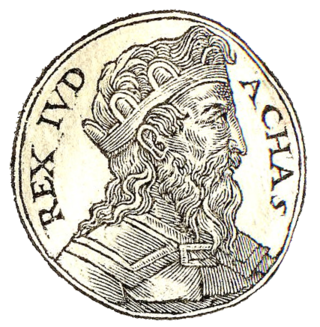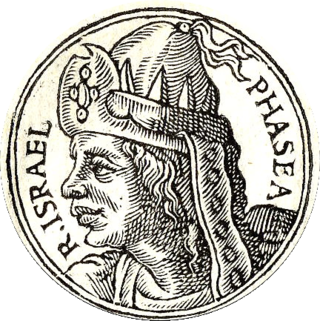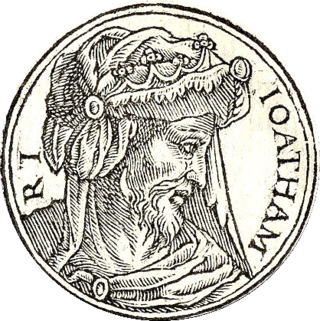
Jehu was the tenth king of the northern Kingdom of Israel since Jeroboam I, noted for exterminating the house of Ahab. He was the son of Jehoshaphat, grandson of Nimshi, and possibly great-grandson of Omri, although the latter notion is not supported by the biblical text. His reign lasted 28 years.

The Kingdom of Israel, Northern Kingdom or Kingdom of Samaria, was an Israelite kingdom in the Southern Levant during the Iron Age, whose beginnings can be dated back to the first half of the 10th century BCE. The kingdom controlled the areas of Samaria, Galilee and parts of Transjordan. The regions of Samaria and Galilee underwent a period with large number of settlements during the 10th century BCE, with the capital in Shechem, and then in Tirzah. The kingdom was ruled by the Omride dynasty in the 9th century BCE, whose political center was the city of Samaria.

Ahaz an abbreviation of Jehoahaz II, "Yahweh has held" was the twelfth king of Judah, and the son and successor of Jotham. Ahaz was 20 when he became king of Judah and reigned for 16 years.

Tiglath-Pileser III was the king of the Neo-Assyrian Empire from 745 BC to his death in 727. One of the most prominent and historically significant Assyrian kings, Tiglath-Pileser ended a period of Assyrian stagnation, introduced numerous political and military reforms and more than doubled the lands under Assyrian control. Because of the massive expansion and centralization of Assyrian territory and establishment of a standing army, some researchers consider Tiglath-Pileser's reign to mark the true transition of Assyria into an empire. The reforms and methods of control introduced under Tiglath-Pileser laid the groundwork for policies enacted not only by later Assyrian kings but also by later empires for millennia after his death.

Pekah was the eighteenth and penultimate king of Israel. He was a captain in the army of king Pekahiah of Israel, whom he killed to become king. Pekah was the son of Remaliah.

Dan is an ancient city mentioned in the Hebrew Bible, described as the northernmost city of the Kingdom of Israel, and belonging to the tribe of Dan, its namesake. It was later the site of a royal sanctuary built by Jeroboam.

Hoshea was the nineteenth and last king of the northern Kingdom of Israel and son of Elah. William F. Albright dated his reign to 732–721 BCE, while E. R. Thiele offered the dates 732–723 BCE.

Menahem or Menachem was the sixteenth king of the northern Israelite Kingdom of Israel. He was the son of Gadi, and the founder of the dynasty known as the House of Gadi or House of Menahem.

Jotham or Yotam was the eleventh king of Judah, and son of Uzziah and Jerusha, daughter of Zadok. Jotham was 25 years old when he began his reign, and he reigned for 16 years. Edwin R. Thiele concluded that his reign commenced as a coregency with his father, which lasted for 11 years. Because his father Uzziah was afflicted with tzaraath after he went into the Temple to burn incense, Jotham became governor of the palace and the land at that time, i.e. coregent, while his father lived in a separate house as a leper.

The Tel Dan Stele is a fragmentary stele containing an Aramaic inscription which dates to the 9th century BCE. It is the earliest known extra-biblical archaeological reference to the house of David.

Hazael was a king of Aram-Damascus mentioned in the Bible. Under his reign, Aram-Damascus became an empire that ruled over large parts of contemporary Syria and Israel-Samaria. While he was likely born in the greater Damascus region of today, his exact place of birth is still controversial, with both Bashan and the Beqaa Valley being favoured by different historians.

The Kingdom of Aram-Damascus was an Aramean polity that existed from the late-12th century BCE until 732 BCE, and was centred around the city of Damascus in the Southern Levant. Alongside various tribal lands, it was bounded in its later years by the polities of Assyria to the north, Ammon to the south, and Israel to the west.
The Syro-Ephraimite War was a conflict which took place in the 8th century BC between the Kingdom of Judah and an alliance of Aram-Damascus and the Kingdom of Israel based in Samaria. In 735 BC, kings Rezin of Aram-Damascus and Pekah of Israel, attempted to depose king Ahaz of Judah through an invasion. Judah was defeated and, according to 2 Chronicles 28, lost 120,000 troops in just one day. Many significant officials were killed, including the king's son Maaseiah. Many others were taken away as slaves. Telling of the same war, 2 Kings 16:5 states that Rezin and Pekah besieged Jerusalem but failed to capture it. During the invasion, the Philistines and Edomites were taking advantage of the situation and raiding towns and villages in Judah. In turn, Ahaz asked Tiglath-Pileser III of Assyria for help.

The Omride dynasty, Omrides or House of Omri were the ruling dynasty of the Kingdom of Samaria founded by King Omri. The dynasty's rule ended with the murder of Zechariah of Israel by Shallum in 752 BCE, who was then killed by Menahem in the next month.
Rezin of Aram was an Aramean King ruling from Damascus during the 8th century BC. During his reign, he was a tributary of King Tiglath-Pileser III of Assyria.

The article deals with the biblical and historical kings of the Land of Israel - Abimelech of Sichem, the three kings of the United Kingdom of Israel and those of its successor states, Israel and Judah, followed in the Second Temple period, part of classical antiquity, by the kingdoms ruled by the Hasmonean and Herodian dynasties.

2 Kings 16 is the sixteenth chapter of the second part of the Books of Kings in the Hebrew Bible or the Second Book of Kings in the Old Testament of the Christian Bible. The book is a compilation of various annals recording the acts of the kings of Israel and Judah by a compiler in the seventh century BCE with a supplement added in the sixth century BCE. This chapter records the events during the reign of Ahaz, the king of Judah.

2 Kings 18 is the eighteenth chapter of the second part of the Books of Kings in the Hebrew Bible or the Second Book of Kings in the Old Testament of the Christian Bible. The book is a compilation of various annals recording the acts of the kings of Israel and Judah by a Deuteronomic compiler in the seventh century BCE, with a supplement added in the sixth century BCE. This chapter records the events during the reign of Hezekiah, the king of Judah, a part of the section comprising 2 Kings 18:1 to 20:21, with a parallel version in Isaiah 36–39.

2 Kings 15 is the fifteenth chapter of the second part of the Books of Kings in the Hebrew Bible or the Second Book of Kings in the Old Testament of the Christian Bible. The book is a compilation of various annals recording the acts of the kings of Israel and Judah by a Deuteronomic compiler in the seventh century BCE, with a supplement added in the sixth century BCE. This chapter records the events during the reigns of Azariah (Uzziah) and his son, Jotham, the kings of Judah, as well as of Zechariah, Shallum, Menahem, Pekahiah and Pekah, the kings of Israel. Twelve first verses of the narrative belong to a major section 2 Kings 9:1–15:12 covering the period of Jehu's dynasty.















